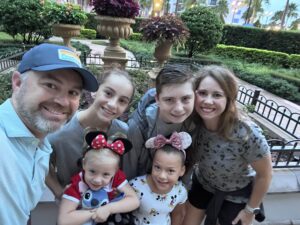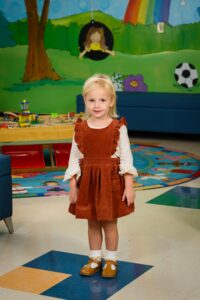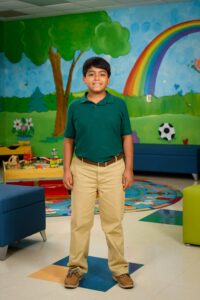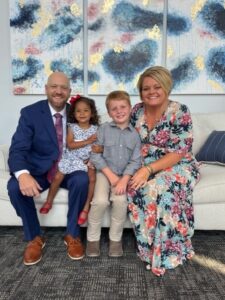By Katie Ginn
In honor of National Adoption Awareness Month, we talked with four adoptive families from Mississippi. Their stories are all different, but they all present a picture of the gospel, in which God has adopted believers into His family (Ephesians 1:5)! If these stories inspire you to learn more about adoption, check out this month’s Feature Story for more resources.
Jay and Andrea Gulley

- Biological kids Walker and Lyndon, 13 and 12 years old, respectively
- Adopted daughter Gemma Rose, adopted in Mississippi at a few months old, now 5 years old
- Adopted daughter Torren, fostered in Mississippi at 4 days old, adopted at 22 months old; now 3 years old
- How the Gulleys adopted: Through an agency (domestically) for Gemma Rose; through foster care for Torren
- A favorite family memory for Gemma Rose: Going to Disney World!
How they decided

“It was actually not on my radar,” says Jay, despite the fact that both he and his sister were adopted. If anything, he thought they might end up bringing home a child in need through a personal relationship, as depicted in the movie “The Blind Side.”
For Andrea, “the Lord just kept speaking to me through every sermon, every podcast, every Bible study – I think we’re called to do this,” she recalls. “I literally wrote (Jay) a letter (about it).” He read the letter and said yes.
Because the Gulleys already had two young biological kids, international travel would be complicated. So Jay and Andrea opted for a domestic adoption. Thirteen months later, the Gulleys brought Gemma Rose home.
Maybe six months after that, Andrea wanted to adopt again, and Jay said no – at first. Another year went by, and then “I wrote him another letter,” she says. This time, she felt led to foster care, but she was scared. She didn’t mention foster care in the letter.
When Jay read it, he again agreed to adopt – and without knowing Andrea’s thoughts, added, “But I think it needs to be foster care.”
Foster care always aims to reunify biological families. However, in a rare occurrence, the Gulleys had the opportunity to adopt their very first foster child, Torren.
Challenges and fears

“I was a little worried … could I love a kid as much as I do my biologicals? But the second they put (Gemma Rose) in my arms, that was not a problem,” Jay says.
“One of our other fears was the birth family, the unknown of what that relationship would look like,” Andrea adds. “We had matched with a girl prior to Gemma Rose, and she had not placed with us. I think that was the Lord (helping us) realize this is not just about a child. … This is a full circle ministry to birth families (too).
“Gemma Rose’s birth family we do keep a connection with, and it’s a beautiful, beautiful story.”
Navigating the foster system with Torren’s adoption was probably the Gulleys’ biggest challenge.
“It’s an emotional roller coaster,” Andrea says. “(But) we would do it all over again. … it’s in the difficult places that you feel the nearness of the Lord.”
Surprises and blessings
Andrea has been surprised how much adoption has impacted her marriage and her family.
“We get to show (our biological kids) the gospel through this process. (And it) allows my dad in his work to say, ‘This is my adopted granddaughter.’”
Also, “We’ve found a network of other (foster and adoptive families),” Jay adds.
That support network is necessary, Andrea says, “because (when you adopt) you’re on mission … So having like-minded people who understand it (is crucial). I’ve felt like, stepping into this world, I’m in a different place and a different relationship with my Lord and Savior.”
Advice for couples considering adoption
“Do it,” Jay says.
“Call us,” Andrea adds. She and Jay love having dinner with folks who are interested in foster care or adoption.
“Do your research, and don’t be afraid to step into the unknown. For a known God is there to carry you through it,” Andrea says. “You won’t wish you wouldn’t have stepped into a birth mom’s life, stepped into a child’s life.”
“Even when it’s hard, you don’t regret the sacrifices you made,” Jay says.
Bo and Rebekah Rice

- Biological kids Garrett, Hannah, and Samuel, ages 19, 17, and 14, respectively
- Adopted son Nathan, fostered at 9 months old, adopted at 23 months old, now 9 years old
- Adopted daughter Savanna Ruth, fostered at 2 weeks old, adopted at 26 months old, now 5 years old
- How the Rices adopted: Through foster care in Louisiana, while living there
- Nathan’s favorite thing about his family: “How we do fun things together, like go fun places and have movie nights at home.”
- Savanna Ruth’s favorite thing about her family: “I like playing with my family.”
- All three biological Rice kids said – without the others knowing! – that they do not think of Nathan and Savanna Ruth as “adopted,” and that there is no difference.
How they decided
After experiencing infertility and not knowing if they’d ever get pregnant, the Rices committed to adoption – and then, miraculously, had three biological kids with no medical intervention.
“But the Lord never released us from the call to adoption,” Rebekah says.
Why foster care?

In 2014, Bo asked if Rebekah would consider foster care. “I told him, ‘You are crazy.’” She could never love a child and then give him or her back.
In 2015, they moved to New Orleans, where they attended a conference for families interested in foster care. Rebekah heard a woman speak whose family had fostered 50 children over the years before finally being able to adopt. That woman said her family decided they were called to foster care. They’d also asked themselves, “Is this harder than what Jesus did for us on the cross?”
That was all it took. By fall 2016, the Rices were certified for foster care – and were preparing to foster 50 kids, with no guarantee of an adoption! But Bo and Rebekah soon got a call about a baby boy, who came home with them in December and never left.
The Rices kept their home open for foster care – despite a 2019 placement that lasted only one week and “absolutely about wrecked us,” Rebekah says. Then, on February 7, 2020, they got the call for Savanna Ruth.
Challenges

Both Nathan and Savanna Ruth were born into addiction. So in the midst of New Orleans’ strict COVID-19 regulations and the older kids’ strenuous online learning during the pandemic, the Rices were “living” at doctors’ offices as Savanna Ruth endured severe drug withdrawals.
“When she was hungry, it registered as pain; when she would eat, it registered as pain,” Rebekah says. “She literally cried for nine months. It would take me an hour to get two ounces of formula down her. She had low muscle tone, so we had to start physical therapy. … That progressed as she got older into occupational therapy.”
Finally, after about nine months, Savanna Ruth started sleeping and eating.
This past Christmas, after moving to Mississippi, the Rices noticed that Savanna Ruth was losing her ability to walk. After a muscle biopsy this summer, it appears she might have a mitochondrial disease, possibly related to another disease or condition. So the Rices are getting referrals out to children’s hospitals that specialize in mitochondrial disease, as well as looking at research hospitals that might take her case.
“It’s been really scary,” Rebekah says. “There’s still a lot of unknowns as far as her prognosis … But she is thriving in kindergarten. And we have gotten excellent medical care at Batson. (We) have seen the Lord’s hand in her story from the very beginning.”
Advice for couples considering foster care or adoption
“Talk with families that have done it,” Bo says. “Get some preparation. Because it is hard. … But walking the journey with people who’ve been through it is also very encouraging. So finding some kind of support group is necessary.”
Also: “A lot of times we think if we get this child in our home and provide a loving home, then they’ll heal,” Rebekah says. “But you’ve got to have trauma-informed training … Even in utero, babies experience trauma that impacts their brain. And it’s a lifelong journey of healing.
“Ultimately, it’s a beautiful redemption story, because we’re all broken and we’re all in need of Jesus.”
Clint and Amanda (Gulley) Hatch

- Noah, adopted from Honduras at 2 years old, now 10
- Aniyah Grace, adopted in Mississippi at 6 days old, now 6 years old
- How the Hatches adopted: Via agencies (internationally for Noah, domestically for Aniyah Grace)
- Aniyah Grace’s favorite thing about her family: “I like to play with them.”
- Noah’s favorite thing about his family: “They’re nice.”
How they decided
Like her brother Jay Gulley, Amanda was adopted. Still, adopting her own kids “wasn’t on my radar either, which is weird,” she says. “But basically, we got to a point where we had to decide (between) medical options or adoption.
“Clint first felt the call for adoption, and I just kind of shut that down once or twice when he asked. I was just ‘stuck’ on having biological children and hesitant about how I would feel about bringing in non-biological children.”
Then one night, she Googled adoption without Clint knowing. The next morning, “our pastor preached specifically toward caring for orphans,” Amanda says.
Clint recalls their drive home that day: “I remember thinking, ‘Should I say anything, or should I not?’ And finally, I just hesitantly (asked her what she thought).” Amanda admitted to her Google search and said the sermon had confirmed that they needed to adopt.
Why Honduras?

“First, God led us to adopt internationally,” Clint recalls. Then, after choosing an adoption agency, the Hatches zeroed in on three countries based on their restrictions and requirements: Honduras, Ethiopia, and Bulgaria.
Thanks to mission trips to Guatemala, the Hatches felt a pull toward Central American culture. “You can’t adopt from Guatemala, and Honduras was the next closest, culturally,” Amanda says.
Why adopt domestically?

The Hatches were number 70 on the waiting list for a Honduran adoption and ultimately waited six years before bringing Noah home. The wait was more than worth it, but Clint and Amanda weren’t getting any younger as they aimed to adopt again.
Their adoption agency, Lifeline Children’s Services, was pushing adoptions of Mississippi children, “and we just felt the need there,” Clint says.
Unlike their international adoption, there was no “first-come, first-served” waiting list. Instead, the Hatches had to create a family scrapbook for birth mothers to peruse. Clint and Amanda could’ve sat around for years while birth mothers selected other couples. Fortunately, a birth mom chose them in about six months, and they brought Aniyah Grace home.
Challenges and fears
The Hatches wondered how they’d be accepted as a multicultural family. “That has turned out, of course, to be insignificant,” Amanda says.
“It’s been more of a thing of curiosity,” Clint says. “I pray God can use that to speak to people.”
Another unexpected trial turned into a blessing: Two and a half years into their six-year wait to adopt Noah, Amanda was diagnosed with stage 4 non-Hodgkin’s lymphoma. A fundraiser was done for her cancer treatments, but “I didn’t have to use any of that, because my insurance covered it all,” she says.
“All of that (money raised) was almost exactly the amount we needed for Noah’s adoption (at that point).”
As of July 2025, Amanda is 10 years cancer-free.
She and Clint have open discussions with their kids about being adopted. “As they get older, it’ll be a little more difficult, I’m sure, as other questions arise,” Amanda says. “(We just want) to assure them they’re loved and they’re chosen.”
Biggest surprise
“Maybe just how natural everything has seemed,” Amanda says. “This is our family. These are our babies, and we’re they’re parents. (After we adopted), I said I wasn’t sure I could love biological children as much as I love these!”
Advice for couples considering adoption
“Do it. Do it now. Don’t wait!” Amanda says.
“You need to be praying about it as a couple,” Clint says. “So when I was feeling the pull for it, one of our pastors said, just be patient with your wife. … and God has to be in the middle of it. But once you’re on the same page … you’ve got to step out in faith.”
Jacob and Katie Gable

- Biological son Gus, 8
- Adopted daughter Olivia, adopted as a newborn from Texas, now 2 and a half years old
- How the Gables adopted: via an agency (domestically)
- Olivia’s favorite thing about her family: “If I had to answer that, I think it would be her brother,” Jacob says. “She’s obsessed with him.”
- Gus’ favorite part of the adoption story: “Finding out that I was going to have a little sister.”
How they decided
“We had some fertility issues (and) were considering adopting when we found out we were pregnant with (Gus),” Katie says.
When Gus was a year and a half old, Katie was diagnosed with stage 3 melanoma – which had been fed by pregnancy hormones. She underwent treatment and was told, “You’ll be fine as long as you don’t have any more babies.”
“That was devastating,” Katie says. “But that just turned us back around to adoption.”
Why adopt domestically?
“We considered fostering, but given Gus’ age, we thought that might be a little traumatic for him if it didn’t work out,” Katie says.
An international adoption would require them to be away from Gus and their jobs for too long, and some countries were closing adoptions with no notice. So Jacob and Katie chose to adopt domestically.
From Christmas to Easter
In December 2022, ten months after starting the adoption process, the Gables were matched with a birth mom on the coast and drove down for the birth. Then the mom changed her mind at the hospital.
“It was five days before Christmas,” Katie says.
After taking several days to grieve and finally posting the news on Facebook, they heard from a girl at their church who knew a birth mom in Texas who needed help.
“It would kind of come together and it would fall apart (over the next few months),” Katie says. “We had put a lawyer on retainer, and (the mom) would never contact them.”
Finally, one day that spring, Katie wasn’t feeling great and stayed home from work. She was bored, started praying – and heard God tell her to call that Texas birth mom.
The very next day, the Gables traveled to Texas for the birth. The following Saturday, they came home as a family of four – just in time for Easter.
The biggest surprise: It’s a girl!

The birth mom had been told initially that she was having a boy, but she never went back for another ultrasound.
On their way to the hospital, the Gables got a call: “She’s here!” She??
When Katie and Jacob told Gus he was getting a baby sister, he quipped, “Well, I knew that, because that’s what God and I talked about.”
Challenges and fears
“We thought we couldn’t afford it,” Katie says. “We thought we had to literally come up with $25,000-plus.”
Then they discovered grants through organizations like Lifesong, Hearts of Compassion, and Zacchaeus Tree – a ministry of Crossgates Church in Brandon, founded by the late Chris Gray, who was a huge influence in the Gables’ choosing to adopt.
The biggest challenge now? “We can look at Gus and understand what he’s doing and why he’s doing it, because we see us (in him),” Jacob says. “But there are things that Olivia does that we don’t see in us, and it’s just like, how do we combat that?”
Advice for couples considering adoption
“Have an open mind and heart,” Jacob says. “It was amazing to see how many people were able to donate (toward Olivia’s adoption) … and now they get to see the fruits of their dollars (when they see her at church). They’ll have an even bigger impact on her life as she grows up.”
“Don’t give in to the fear,” Katie says. “And allow people to help you. And if anybody has any questions or is considering, reach out to us.”
Also, “be part of an organization. Zaccheus Tree has adoption classes every first and third Wednesday at Crossgates, for free.”